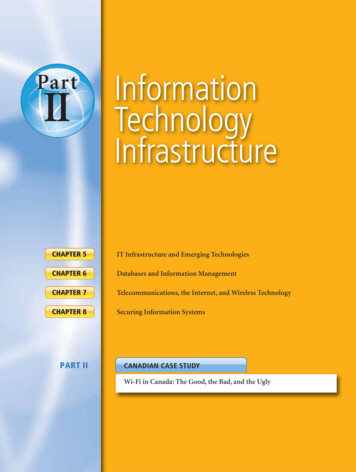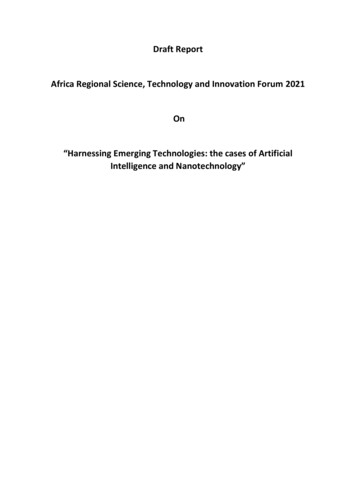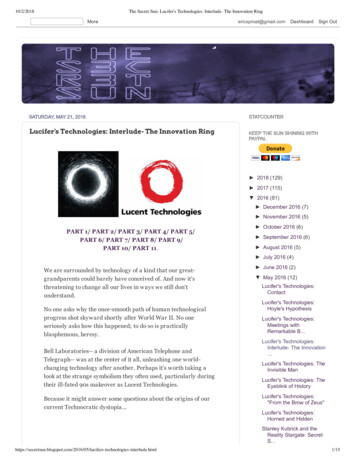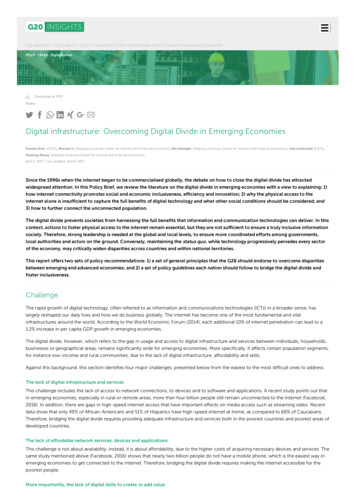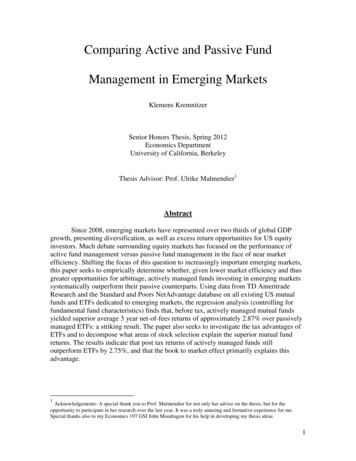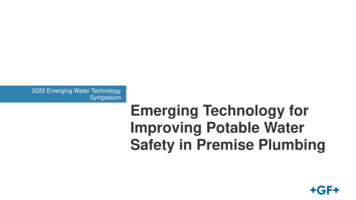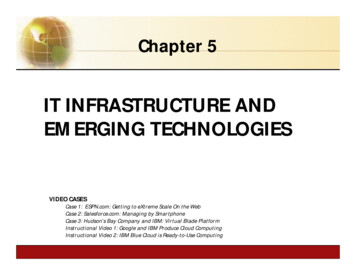
Transcription
Chapter 5IT INFRASTRUCTURE ANDEMERGING TECHNOLOGIESVIDEO CASESCase 1: ESPN.com: Getting to eXtreme Scale On the WebCase 2: Salesforce.com: Managing by SmartphoneCase 3: Hudson's Bay Company and IBM: Virtual Blade PlatformInstructional Video 1: Google and IBM Produce Cloud ComputingInstructional Video 2: IBM Blue Cloud is Ready-to-Use Computing
Management Information SystemsChapter 5: IT Infrastructure and Emerging TechnologiesLEARNING OBJECTIVES Define IT infrastructure and describe itscomponents. Identify and describe the stages and technologydrivers of IT infrastructure evolution. Assess contemporary computer hardware platformtrends. Assess contemporary software platform trends. Evaluate the challenges of managing ITinfrastructure and management solutions.5.2Copyright 2014 Pearson Education, Inc.
Management Information SystemsChapter 5: IT Infrastructure and Emerging TechnologiesThe Army Recasts its IT Infrastructure Problem: Costly and unwieldy ITinfrastructure; diminishing resources Solutions:– Streamline data centers– Implement enterprise-wide computing– Employ new technologies: virtualization, mobilesystems Demonstrates IT’s role in improvingperformance and decreasing costs5.3Copyright 2014 Pearson Education, Inc.
Management Information SystemsChapter 5: IT Infrastructure and Emerging TechnologiesIT Infrastructure IT infrastructure:– Set of physical devices and software required tooperate enterprise– Set of firmwide services including: Computing platforms providing computing servicesTelecommunications servicesData management servicesApplication software servicesPhysical facilities management servicesIT management, education, and other services– “Service platform” perspective More accurate view of value of investments5.4Copyright 2014 Pearson Education, Inc.
Management Information SystemsChapter 5: IT Infrastructure and Emerging TechnologiesCONNECTION BETWEEN THE FIRM, IT INFRASTRUCTURE, AND BUSINESS CAPABILITIESFIGURE 5-15.5The services a firm is capable of providing to its customers, suppliers, and employees are a direct function ofits IT infrastructure. Ideally, this infrastructure should support the firm’s business and information systemsstrategy. New information technologies have a powerful impact on business and IT strategies, as well as theservices that can be provided to customers.Copyright 2014 Pearson Education, Inc.
Management Information SystemsChapter 5: IT Infrastructure and Emerging TechnologiesIT Infrastructure Evolution of IT infrastructure– General-purpose mainframe and minicomputer era: 1959to present 1958: IBM first mainframes introduced 1965: less expensive DEC minicomputers introduced– Personal computer era: 1981 to present 1981: Introduction of IBM PC Proliferation in 80s, 90s resulted in growth of personal software– Client/server era: 1983 to present Desktop clients networked to servers, with processing work splitbetween clients and servers Network may be two-tiered or multitiered (N-tiered) Various types of servers (network, application, Web)5.6Copyright 2014 Pearson Education, Inc.
Management Information SystemsChapter 5: IT Infrastructure and Emerging TechnologiesIT Infrastructure Evolution of IT infrastructure (cont.)– Enterprise computing era: 1992 to present Move toward integrating disparate networks,applications using Internet standards and enterpriseapplications– Cloud and mobile computing: 2000 to present Cloud computing: computing power and softwareapplications supplied over the Internet or othernetwork– Fastest growing form of computing5.7Copyright 2014 Pearson Education, Inc.
Management Information SystemsChapter 5: IT Infrastructure and Emerging TechnologiesSTAGES IN IT INFRASTRUCTURE EVOLUTIONIllustrated here are the typicalcomputing configurationscharacterizing each of the fiveeras of IT infrastructureevolution.FIGURE 5-25.8Copyright 2014 Pearson Education, Inc.
Management Information SystemsChapter 5: IT Infrastructure and Emerging TechnologiesSTAGES IN IT INFRASTRUCTURE EVOLUTION (cont.)Illustrated here are the typicalcomputing configurationscharacterizing each of the fiveeras of IT infrastructureevolution.FIGURE 5-25.9Copyright 2014 Pearson Education, Inc.
Management Information SystemsChapter 5: IT Infrastructure and Emerging TechnologiesA MULTITIERED CLIENT/SERVER NETWORK (N-TIER)FIGURE 5-35.10In a multitiered client/server network, client requests for service are handled by different levels of servers.Copyright 2014 Pearson Education, Inc.
Management Information SystemsChapter 5: IT Infrastructure and Emerging TechnologiesIT Infrastructure Technology drivers of infrastructureevolution– Moore’s law and microprocessing power Computing power doubles every 18 months Nanotechnology:– Shrinks size of transistors to size comparable to sizeof a virus– Law of Mass Digital Storage The amount of data being stored each yeardoubles5.11Copyright 2014 Pearson Education, Inc.
Management Information SystemsChapter 5: IT Infrastructure and Emerging TechnologiesMOORE’S LAW AND MICROPROCESSOR PERFORMANCEPacking more than 2 billiontransistors into a tinymicroprocessor hasexponentially increasedprocessing power. Processingpower has increased to morethan 500,000 MIPS (millions ofinstructions per second).FIGURE 5-45.12Copyright 2014 Pearson Education, Inc.
Management Information SystemsChapter 5: IT Infrastructure and Emerging TechnologiesFALLING COST OF CHIPSPacking more transistors intoless space has driven downtransistor cost dramatically aswell as the cost of the productsin which they are used.FIGURE 5-55.13Copyright 2014 Pearson Education, Inc.
Management Information SystemsChapter 5: IT Infrastructure and Emerging TechnologiesEXAMPLES OF NANOTUBESNanotubes are tiny tubes about10,000 times thinner than ahuman hair. They consist ofrolled up sheets of carbonhexagons and have thepotential uses as minusculewires or in ultrasmall electronicdevices and are very powerfulconductors of electrical current.FIGURE 5-65.14Copyright 2014 Pearson Education, Inc.
Management Information SystemsChapter 5: IT Infrastructure and Emerging TechnologiesTHE COST OF STORING DATA DECLINES EXPONENTIALLY 1950–2012Since the first magnetic storagedevice was used in 1955, thecost of storing a kilobyte ofdata has fallen exponentially,doubling the amount of digitalstorage for each dollarexpended every 15 months onaverage.FIGURE 5-75.15Copyright 2014 Pearson Education, Inc.
Management Information SystemsChapter 5: IT Infrastructure and Emerging TechnologiesIT Infrastructure Technology drivers of infrastructure evolution (cont.)– Metcalfe’s Law and network economics Value or power of a network growsexponentially as a function of the number ofnetwork members As network members increase, more peoplewant to use it (demand for network accessincreases)5.16Copyright 2014 Pearson Education, Inc.
Management Information SystemsChapter 5: IT Infrastructure and Emerging TechnologiesIT Infrastructure Technology drivers of infrastructure evolution (cont.)– Declining communication costs and the Internet An estimated 2.3 billion people worldwide haveInternet access As communication costs fall toward a verysmall number and approach 0, utilization ofcommunication and computing facilitiesexplodes5.17Copyright 2014 Pearson Education, Inc.
Management Information SystemsChapter 5: IT Infrastructure and Emerging TechnologiesEXPONENTIAL DECLINES IN INTERNET COMMUNICATIONS COSTSFIGURE 5-85.18One reason for the growth in the Internet population is the rapid decline in Internet connection and overallcommunication costs. The cost per kilobit of Internet access has fallen exponentially since 1995. Digital subscriberline (DSL) and cable modems now deliver a kilobit of communication for a retail price of around 2 cents.Copyright 2014 Pearson Education, Inc.
Management Information SystemsChapter 5: IT Infrastructure and Emerging TechnologiesIT Infrastructure Technology drivers of infrastructureevolution (cont.)– Standards and network effects Technology standards:– Specifications that establish the compatibility ofproducts and the ability to communicate in anetwork– Unleash powerful economies of scale and result inprice declines as manufacturers focus on theproducts built to a single standard5.19Copyright 2014 Pearson Education, Inc.
Management Information SystemsChapter 5: IT Infrastructure and Emerging TechnologiesInfrastructure Components IT Infrastructure has seven main components1.2.3.4.5.6.7.5.20Computer hardware platformsOperating system platformsEnterprise software applicationsData management and storageNetworking/telecommunications platformsInternet platformsConsulting system integration servicesCopyright 2014 Pearson Education, Inc.
Management Information SystemsChapter 5: IT Infrastructure and Emerging TechnologiesTHE IT INFRASTRUCTURE ECOSYSTEMThere are seven majorcomponents that must becoordinated to provide the firmwith a coherent ITinfrastructure. Listed here aremajor technologies andsuppliers for each component.FIGURE 5-95.21Copyright 2014 Pearson Education, Inc.
Management Information SystemsChapter 5: IT Infrastructure and Emerging TechnologiesInfrastructure Components Computer hardware platforms– Client machines Desktop PCs, mobile devices—PDAs, laptops– Servers Blade servers: ultrathin computers stored in racks– Mainframes: IBM mainframe equivalent to thousands of bladeservers– Top chip producers: AMD, Intel, IBM– Top firms: IBM, HP, Dell, Sun Microsystems5.22Copyright 2014 Pearson Education, Inc.
Management Information SystemsChapter 5: IT Infrastructure and Emerging TechnologiesInfrastructure Components Operating system platforms– Operating systems Server level: 65% run Unix or Linux; 35% run Windows Client level:– 90% run Microsoft Windows (XP, 2000, CE, etc.)– Mobile/multitouch (Android, iOS)– Cloud computing (Google’s Chrome OS) Enterprise software applications– Enterprise application providers: SAP and Oracle– Middleware providers: BEA5.23Copyright 2014 Pearson Education, Inc.
Management Information SystemsChapter 5: IT Infrastructure and Emerging TechnologiesInfrastructure Components Data management and storage– Database software: IBM (DB2), Oracle, Microsoft (SQL Server),Sybase (Adaptive Server Enterprise), MySQL– Physical data storage: EMC Corp (large-scale systems), Seagate,Maxtor, Western Digital– Storage area networks (SANs): Connect multiple storage devices on dedicatednetwork5.24Copyright 2014 Pearson Education, Inc.
Management Information SystemsChapter 5: IT Infrastructure and Emerging TechnologiesInfrastructure Components Networking/telecommunications platforms– Telecommunication services Telecommunications, cable, telephonecompany charges for voice lines and Internetaccess AT&T, Verizon– Network operating systems: Windows Server, Linux, Unix– Network hardware providers: Cisco, Alcatel-Lucent, Nortel, Juniper Networks5.25Copyright 2014 Pearson Education, Inc.
Management Information SystemsChapter 5: IT Infrastructure and Emerging TechnologiesInfrastructure Components Internet platforms– Hardware, software, management services tosupport company Web sites, (including Webhosting services) intranets, extranets– Internet hardware server market: IBM, Dell, Sun(Oracle), HP– Web development tools/suites: Microsoft(Expression Studio, .NET) Oracle-Sun (Java),Adobe, Real Networks5.26Copyright 2014 Pearson Education, Inc.
Management Information SystemsChapter 5: IT Infrastructure and Emerging TechnologiesInfrastructure Components Consulting and system integration services– Even large firms do not have resources for fullrange of support for new, complex infrastructure– Software integration: ensuring newinfrastructure works with legacy systems– Legacy systems: older TPS created formainframes that would be too costly to replaceor redesign– Accenture, IBM Global Services, EDS, Infosys,Wipro5.27Copyright 2014 Pearson Education, Inc.
Management Information SystemsChapter 5: IT Infrastructure and Emerging TechnologiesContemporary Hardware Platform Trends The mobile digital platform– Cell phones, smartphones (iPhone, Android, andBlackberry) Data transmission, Web surfing, e-mail, and IMduties– Netbooks: Small lightweight notebooks optimized forwireless communication and core tasks– Tablets (iPad)– Networked e-readers (Kindle and Nook)5.28Copyright 2014 Pearson Education, Inc.
Management Information SystemsChapter 5: IT Infrastructure and Emerging TechnologiesContemporary Hardware Platform Trends BYOD (Bring your own device)– Allowing employees to use personal mobile devicesin workplace Consumerization of IT– New information technology emerges in consumermarkets first and spreads to business organizations– Forces businesses and IT departments to rethinkhow IT equipment and services are acquired andmanaged5.29Copyright 2014 Pearson Education, Inc.
Management Information SystemsChapter 5: IT Infrastructure and Emerging TechnologiesInteractive Session: ManagementSHOULD YOU USE YOUR IPHONE FOR WORK?Read the Interactive Session and discuss the following questions What are the advantages and disadvantages of allowingemployees to use their personal smartphones for work? What management, organization, and technology factorsshould be addressed when deciding whether to allowemployees to use their personal smartphones for work? Allowing employees to use their own smartphones forwork will save the company money. Do you agree?5.30Copyright 2014 Pearson Education, Inc.
Management Information SystemsChapter 5: IT Infrastructure and Emerging TechnologiesContemporary Hardware Platform Trends Grid computing– Connects geographically remote computers into asingle network to combine processing power andcreate virtual supercomputer– Provides cost savings, speed, agility Virtualization– Allows single physical resource to act as multipleresources (i.e., run multiple instances of OS)– Reduces hardware and power expenditures– Facilitates hardware centralization5.31Copyright 2014 Pearson Education, Inc.
Management Information SystemsChapter 5: IT Infrastructure and Emerging TechnologiesContemporary Hardware Platform Trends Cloud computing– On-demand (utility) computing services obtainedover network Infrastructure as a service Platform as a service Software as a service––––5.32Cloud can be public or privateAllows companies to minimize IT investmentsDrawbacks: Concerns of security, reliabilityHybrid cloud computing modelCopyright 2014 Pearson Education, Inc.
Management Information SystemsChapter 5: IT Infrastructure and Emerging TechnologiesCLOUD COMPUTING PLATFORMIn cloud computing, hardwareand software capabilities are apool of virtualized resourcesprovided over a network, oftenthe Internet. Businesses andemployees have access toapplications and ITinfrastructure anywhere, at anytime, and on any device.Figure 5-105.33Copyright 2014 Pearson Education, Inc.
Management Information SystemsChapter 5: IT Infrastructure and Emerging TechnologiesContemporary Hardware Platform Trends Green computing– Practices and technologies for manufacturing, using,disposing of computing and networking hardware High performance, power-saving processors– Multi-core processors Autonomic computing– Industry-wide effort to develop systems that canconfigure, heal themselves when broken, and protectthemselves from outside intruders– Similar to self-updating antivirus software; Apple andMicrosoft both use automatic updates5.34Copyright 2014 Pearson Education, Inc.
Management Information SystemsChapter 5: IT Infrastructure and Emerging TechnologiesInteractive Session: OrganizationsGREEN DATA CENTERS: GOOD FOR BUSINESS?Read the Interactive Session and discuss the following questions What business and social problems does datacenter power consumption cause? What solutions are available for these problems?Are they management, organizational, ortechnology solutions? What are the business benefits and costs of thesesolutions? Should all firms move toward green computing?5.35Copyright 2014 Pearson Education, Inc.
Management Information SystemsChapter 5: IT Infrastructure and Emerging TechnologiesContemporary Software Platform Trends Open-source software:– Produced by community of programmers– Free and modifiable by user– Examples: Apache web server, Mozilla Firefoxbrowser, OpenOffice Linux– Open-source OS– Used in mobile devices, local area networks, Webservers, high-performance computing5.36Copyright 2014 Pearson Education, Inc.
Management Information SystemsChapter 5: IT Infrastructure and Emerging TechnologiesContemporary Software Platform Trends Software for the Web– Java: Object-oriented programming language Operating system, processor-independent– HTML/HTML5 Web page description language Specifies how text, graphics are placed on Web page HTML5 is latest evolution– Includes animation and video processing functionalitypreviously provided by third party add-ons such as Flash5.37Copyright 2014 Pearson Education, Inc.
Management Information SystemsChapter 5: IT Infrastructure and Emerging TechnologiesContemporary Software Platform Trends Web Services– Software components that exchange informationusing Web standards and languages– XML: Extensible Markup Language More powerful and flexible than HTML Tagging allows computers to process dataautomatically5.38Copyright 2014 Pearson Education, Inc.
Management Information SystemsChapter 5: IT Infrastructure and Emerging TechnologiesContemporary Software Platform Trends SOA: Service-oriented architecture– Set of self-contained services that communicate witheach other to create a working software application– Software developers reuse these services in othercombinations to assemble other applications asneeded Example: an “invoice service” to serve whole firm forcalculating and sending printed invoices– Dollar Rent A Car Uses Web services to link online booking system withSouthwest Airlines’ Web site5.39Copyright 2014 Pearson Education, Inc.
Management Information SystemsChapter 5: IT Infrastructure and Emerging TechnologiesHOW DOLLAR RENT A CAR USES WEB SERVICESFIGURE 5-115.40Dollar Rent A Car uses Web services to provide a standard intermediate layer of software to “talk” to othercompanies’ information systems. Dollar Rent A Car can use this set of Web services to link to othercompanies’ information systems without having to build a separate link to each firm’s systems.Copyright 2014 Pearson Education, Inc.
Management Information SystemsChapter 5: IT Infrastructure and Emerging TechnologiesContemporary Software Platform Trends Software outsourcing and cloud services– Three external sources for software: Software packages and enterprise software Software outsourcing– Contracting outside firms to develop software Cloud-based software services– Software as a service (SaaS)– Accessed with Web browser over Internet– Service Level Agreements (SLAs): formal agreement withservice providers5.41Copyright 2014 Pearson Education, Inc.
Management Information SystemsChapter 5: IT Infrastructure and Emerging TechnologiesCHANGING SOURCES OF FIRM SOFTWAREFigure 5-125.42In 2012, U.S. firms will spend more than 279 billion on software. About 35 percent of that ( 98 billion) willoriginate outside the firm, either from enterprise software vendors selling firmwide applications or individualapplication service providers leasing or selling software modules. Another 4 percent ( 11 billion) will beprovided by SaaS vendors as an online cloud-based service.Copyright 2014 Pearson Education, Inc.
Management Information SystemsChapter 5: IT Infrastructure and Emerging TechnologiesContemporary Software Platform Trends Software outsourcing and cloud services(cont.)– Mashups Combinations of two or more online applications, suchas combining mapping software (Google Maps) withlocal content– Apps Small pieces of software that run on the Internet, onyour computer, or on your cell phone– iPhone, Android Generally delivered over the Internet5.43Copyright 2014 Pearson Education, Inc.
Management Information SystemsChapter 5: IT Infrastructure and Emerging TechnologiesManagement Issues Dealing with platform and infrastructurechange– As firms shrink or grow, IT needs to be flexible andscalable– Scalability: Ability to expand to serve larger number of users– For mobile computing and cloud computing New policies and procedures for managing these newplatforms Contractual agreements with firms running clouds anddistributing software required5.44Copyright 2014 Pearson Education, Inc.
Management Information SystemsChapter 5: IT Infrastructure and Emerging TechnologiesManagement Issues Management and governance– Who controls IT infrastructure?– How should IT department be organized? Centralized– Central IT department makes decisions Decentralized– Business unit IT departments make own decisions– How are costs allocated betweendivisions, departments?5.45Copyright 2014 Pearson Education, Inc.
Management Information SystemsChapter 5: IT Infrastructure and Emerging TechnologiesManagement Issues Making wise infrastructure investments– Amount to spend on IT is complex question Rent vs. buy, cloud computing Outsourcing– Total cost of ownership (TCO) model Analyzes direct and indirect costs Hardware, software account for only about 20% of TCO Other costs: Installation, training, support, maintenance,infrastructure, downtime, space, and energy– TCO can be reduced Use of cloud services, greater centralization and standardization ofhardware and software resources5.46Copyright 2014 Pearson Education, Inc.
Management Information SystemsChapter 5: IT Infrastructure and Emerging TechnologiesManagement Issues Competitive forces model for ITinfrastructure investment1.2.3.4.5.6.5.47Market demand for firm’s servicesFirm’s business strategyFirm’s IT strategy, infrastructure, and costInformation technology assessmentCompetitor firm servicesCompetitor firm IT infrastructure investmentsCopyright 2014 Pearson Education, Inc.
Management Information SystemsChapter 5: IT Infrastructure and Emerging TechnologiesCOMPETITIVE FORCES MODEL FOR IT INFRASTRUCTUREFIGURE 5-125.48There are six factors you can use to answer the question, “How much should our firm spend on ITinfrastructure?”Copyright 2014 Pearson Education, Inc.
Management Information SystemsChapter 5: IT Infrastructure and Emerging Technologies5.49Copyright 2014 Pearson Education, Inc.
IT INFRASTRUCTURE AND EMERGING TECHNOLOGIES Chapter 5 VIDEO CASES Case 1: ESPN.com: Getting to eXtreme Scale On the Web Case 2: Salesforce.com: Managing by Smartphone Case 3: Hudson's Bay Company and IBM: Virtual Blade Platform Instructional Video 1: Google and IBM Produce Cloud Computing Instructional Video 2: IBM Blue Cloud is Ready-to-Use .


